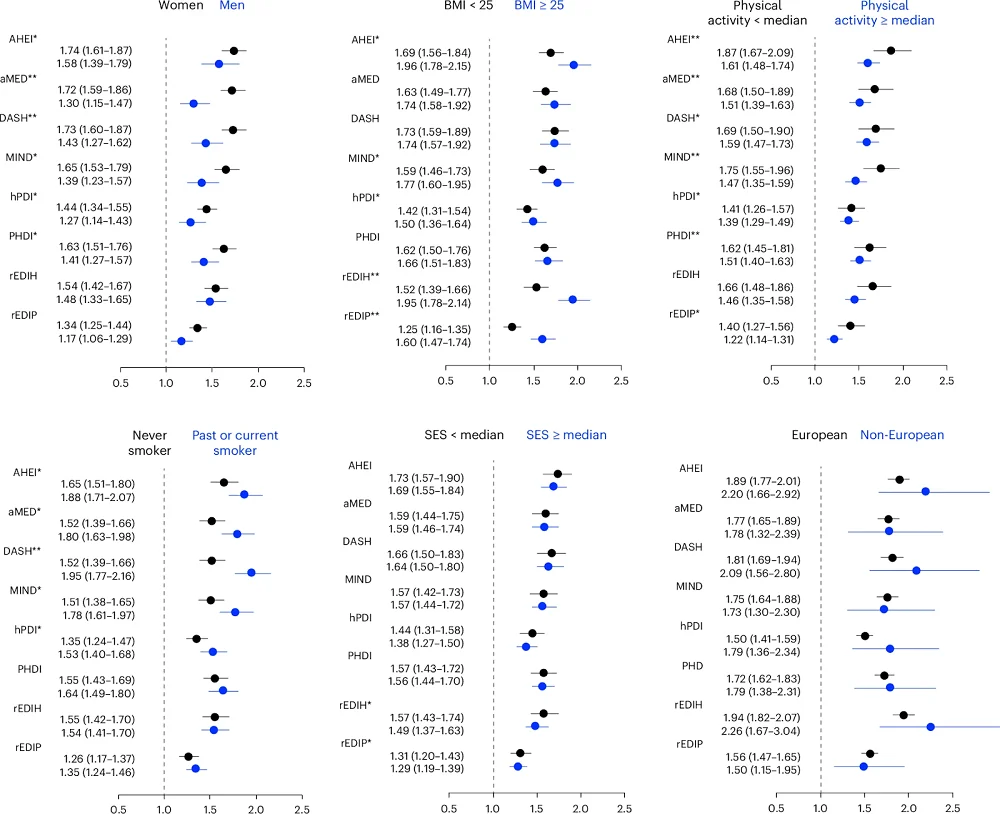A recent study investigated the impact of eight different mid-life dietary patterns on the odds of healthy aging, including cognitive, mental, and physical health [1].
You are what you eat
Diet is an easily modifiable intervention in aging, as what we eat has a tremendous impact on our health. There is a wealth of evidence that good diets can be beneficial in preventing cardiovascular diseases [2], type 2 diabetes [3], and premature mortality [4]. Diet also impacts age-related cognitive decline and physical performance [5, 6]. Apart from being used as a tool to prevent diseases, a proper diet can help to achieve healthier aging and a better quality of life for the elderly.
In this study, the researchers aimed to determine which of the many dietary approaches and nutritional recommendations is the best. They compared the associations between various measurements of aging and long-term adherence to eight healthy dietary patterns.
“Studies have previously investigated dietary patterns in the context of specific diseases or how long people live. Ours takes a multifaceted view, asking, how does diet impact people’s ability to live independently and enjoy a good quality of life as they age?” said the study’s co-corresponding author Frank Hu, Fredrick J. Stare Professor of Nutrition and Epidemiology and chair of the Department of Nutrition at Harvard Chan School.
Eight healthy diets
The dietary approaches included in the study were the Alternative Healthy Eating Index (AHEI), te Alternative Mediterranean Index (aMED), Dietary Approaches to Stop Hypertension (DASH), the Mediterranean-DASH Intervention for Neurodegenerative Delay (MIND), a healthful plant-based diet (hPDI), the Planetary Health Diet Index (PHDI), an empirically dietary inflammatory pattern (EDIP), the empirical dietary index for hyperinsulinemia (EDIH), and ultraprocessed food (UPF) consumption.
Those approaches aim to promote good health by prioritizing healthy foods, such as fruits, vegetables, and whole grains, while reducing red and processed meats; however, there are differences between the diets.
For example, the aMED emphasizes olive oil, fish, and nuts. In the MIND, berries are an essential diet component. The hPDI focuses on plant-based foods, the PHDI focuses on foods that generate low levels of greenhouse gases, and DASH focuses on sodium restriction.
To investigate the impact of those diets on healthy aging, the researchers used the data of 105,015 participants: 70,091 women and 34,924 men from the Nurses’ Health Study (1986-2016) and the Health Professionals Follow-Up Study (1986-2016). They noted that since the study participants were health professionals, it limits the generalizability of results, and similar studies should be conducted on a more diverse population.
In 1986, at the beginning of the data acquisition step, the participants filled out the Food Frequency Questionnaire, which was repeated periodically over 14 years. At the end of the study, the participants’ health in aging was assessed with self-reported questionnaires that suggested that, after up to 30 years of follow-up, 9,771 (9.3%) of the study participants experienced healthy aging.
Healthy diet, healthy aging
The researchers concluded that “higher adherence to all dietary patterns was associated with greater odds of healthy aging.” However, there were differences between dietary patterns.
The strongest association between healthy aging and diet was observed for the AHEI, followed by the reverse EDIH, while the association for the hPDI was the weakest.
When the researchers compared the participants in the lowest 20% of AHEI adherence to those who were in the highest 20%, they reported “86% greater odds of achieving healthy aging using an age cutoff of 70 years and 2.24 times greater odds using an age cutoff of 75 years” that was independent of other lifestyle factors, including physical activity level, smoking, and BMI.
The AHEI was created by the Harvard T.H. Chan School of Public Health researchers. It’s similar to the US Department of Agriculture’s Healthy Eating Index, a measure of adherence to the federal Dietary Guidelines for Americans. The AHEI focuses on foods that help to reduce the risk of chronic disease.
Different diets for different domains of aging
Aging is not uniform; not everyone goes through it the same way, and its various aspects are affected to different degrees in different people. That’s why the researchers analyzed the impact of various dietary patterns on healthy aging in a few different domains. As previously, they noted that higher adherence to all of the tested diets was associated with healthy aging in all tested domains, but there were some differences between the extent of the effects.
Just as in overall healthy aging, the AHEI showed the strongest association with intact physical function and intact mental health. The strongest association for being free from chronic diseases was observed for the reversed EDIH. Intact cognitive health and surviving to 70 are strongly associated with the PHDI.

An apple a day keeps the doctor away
Analysis of individual dietary factors’ impact on healthy aging suggested that healthy aging was associated with higher consumption of fruits, whole grains, vegetables, unsaturated fats, nuts, legumes, and low-fat dairy. Meanwhile, consuming ultraprocessed food, trans fats, sodium, total meats, and red and processed meats decreased the odds of healthy aging. Similar results were observed when different aging domains were analyzed.
“Our findings suggest that dietary patterns rich in plant-based foods, with moderate inclusion of healthy animal-based foods, may promote overall healthy aging and help shape future dietary guidelines,” said co-corresponding author Marta Guasch-Ferré, associate professor in the Department of Public Health at the University of Copenhagen and adjunct associate professor of nutrition at Harvard Chan School.

Different people, different approaches
The researchers also analyzed different subgroups. The authors found that for both men and women, there was an association between all dietary patterns and healthy aging; however, that association was stronger for women for most diets.
For most diets, the associations were also stronger for smokers, participants with a BMI above 25, and those whose physical activity was below the median.
The researchers also reported significant interactions between socioeconomic status and two dietary patterns, reversed EDIH and reversed EDIP. They did not observe any statistically significant interactions between these diets and having European or non-European heritage.

One size doesn’t fit all
While all diets showed benefits, this research has found that different diets have different effects between the sexes and in people with different health concerns. Future studies could address more individualized approaches in detail.
“Our findings also show that there is no one-size-fits-all diet. Healthy diets can be adapted to fit individual needs and preferences,” summarized lead author Anne-Julie Tessier, assistant professor in the Department of Nutrition at the University of Montreal, researcher at the Montreal Heart Institute, and visiting scientist at Harvard Chan School.
Literature
[1] Tessier, A. J., Wang, F., Korat, A. A., Eliassen, A. H., Chavarro, J., Grodstein, F., Li, J., Liang, L., Willett, W. C., Sun, Q., Stampfer, M. J., Hu, F. B., & Guasch-Ferré, M. (2025). Optimal dietary patterns for healthy aging. Nature medicine, 10.1038/s41591-025-03570-5. Advance online publication.
[2] Shan, Z., Li, Y., Baden, M. Y., Bhupathiraju, S. N., Wang, D. D., Sun, Q., Rexrode, K. M., Rimm, E. B., Qi, L., Willett, W. C., Manson, J. E., Qi, Q., & Hu, F. B. (2020). Association Between Healthy Eating Patterns and Risk of Cardiovascular Disease. JAMA internal medicine, 180(8), 1090–1100.
[3] Forouhi, N. G., Misra, A., Mohan, V., Taylor, R., & Yancy, W. (2018). Dietary and nutritional approaches for prevention and management of type 2 diabetes. BMJ (Clinical research ed.), 361, k2234.
[4] English, L. K., Ard, J. D., Bailey, R. L., Bates, M., Bazzano, L. A., Boushey, C. J., Brown, C., Butera, G., Callahan, E. H., de Jesus, J., Mattes, R. D., Mayer-Davis, E. J., Novotny, R., Obbagy, J. E., Rahavi, E. B., Sabate, J., Snetselaar, L. G., Stoody, E. E., Van Horn, L. V., Venkatramanan, S., … Heymsfield, S. B. (2021). Evaluation of Dietary Patterns and All-Cause Mortality: A Systematic Review. JAMA network open, 4(8), e2122277.
[5] Scarmeas, N., Anastasiou, C. A., & Yannakoulia, M. (2018). Nutrition and prevention of cognitive impairment. The Lancet. Neurology, 17(11), 1006–1015.
[6] Tessier, A. J., & Chevalier, S. (2018). An Update on Protein, Leucine, Omega-3 Fatty Acids, and Vitamin D in the Prevention and Treatment of Sarcopenia and Functional Decline. Nutrients, 10(8), 1099.
View the article at lifespan.io








































